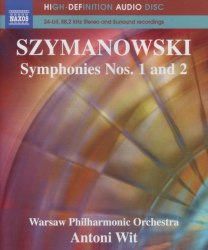| 
|
Karol SZYMANOWSKI (1882-1937)
Symphony No. 1 in F minor, Op. 15 (1907) [18:40]
Symphony No. 2 in B flat major, Op. 19 (1910) [34:38]
Ewa Marczyk (violin solo) (2)
Warsaw National Philharmonic Orchestra/Antoni Wit
rec. 2-3 January 2008 (First Symphony), 16-19 April 2007 (Second Symphony) Philharmonic Hall, Warsaw, Poland
24-bit, 88.2 kHz. 5.1 Surround - DTS-HD Master Audio; 2.0 Stereo - PCM
NAXOS BD-A NBD0021 [53:11]
Rather surprisingly, this disc isn’t a straightforward BD-A reissue of an earlier CD. Instead, Naxos has re-coupled Wit’s recordings of the symphonies. Symphony No. 1 originally appeared in harness with the Fourth Symphony and, in its CD incarnation, was warmly received by Dan Morgan (review). He was also pretty enthusiastic about the CD coupling of the Second Symphony with the Third (review) which was also well received by Kevin Sutton (review). For the BD-A version, however, the first two symphonies now appear together while the Third and Fourth have been coupled together on NBD0022, which I’ve not heard. In the process two shorter works, the Concert Overture Op. 12 and an orchestration of the piano Study in B flat minor, Op. 4/3 have been discarded. That’s a pity for between them they account for some twenty minutes of music and the playing time of both BD-A discs, containing just the symphonies, is a little ungenerous.
The First Symphony was premièred in 1907 but the composer was dissatisfied with it and subsequently withdrew it according to Keith Anderson’s useful notes. In some ways I’m not surprised for in this score Szymanowski seems to me to be struggling to find a distinctive voice. He described the symphony as a ‘contrapuntal-harmonic-orchestral monster’. I think that’s somewhat hyperbolic but the scoring is often busy and sometimes dense although there are many imaginative touches in the orchestration. The use of colour, though individual and attractive is, understandably, much less subtle than the sort of effects he would achieve in later, more mature works. It’s instructive to compare this score with the roughly contemporaneous symphonic works of Mahler and Strauss. I don’t find Szymanowski’s argument at all easy to follow, especially by comparison with the works of those two masters, though I readily admit to less familiarity with Szymanowski’s piece. There seems to be a sense of striving in much of the symphony but I’m not convinced as to where that striving leads us and I don’t get much of a sense of structure. The fact that I find the work hard to come to terms with is in no way a reflection on the committed advocacy of Wit and his players.
With the Second Symphony, first performed in 1911, we are closer to the mature Szymanowski. In terms of the orchestration this may in part reflect the fact that the composer revised this aspect of the score in 1934. Like its predecessor the Second is cast in two movements but the structure is somewhat unusual in that the second movement consists of a theme, six variations - all separately tracked by Naxos - and a concluding fugue. The thematic material and scoring of the first movement is ardent and at times sensuous; at other times the music is downright opulent. I have the sense that in terms of the character of the music Szymanowski is here more at ease and more confident in handing his material and the orchestra than was the case in the previous symphony. The theme and first two variations in the second movement are marked Lento - or, more accurately L’istesso tempo in the case of the variations. The theme itself is gorgeous and here and in the initial variations there are several very delicately scored - and played - passages to enjoy. The tempo picks up for Scherzando Variation III, which is marked Molto vivace; Wit and his orchestra bring out the lightness in the music admirably. After a gavotte and a minuet variation comes the final, quite extensive fugue. This is complex and vigorous but also contains a languorous central section. Overall, I find this a more convincing work that the First Symphony. Once again, Wit and the Warsaw orchestra give it an excellent performance.
I’ve not heard the CDs on which these performances were originally issued. I’d describe the BD-A sound as very good without being revelatory. I suspect that a rival BD-A version of these scores is unlikely to emerge any time soon and happily Wit’s fine and committed performances serve Szymanowski very well.
John Quinn
Previous reviews (CD): Symphony 1 ~~ Symphony 2
 |
 |
|
